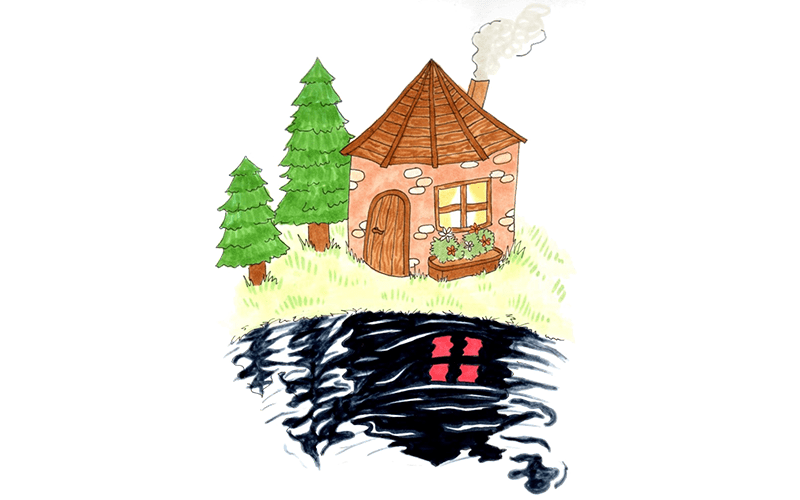It is hard to deny that there is something soothing about the images of cosy, flower-covered cottages, home-made bread and hand-picked mushrooms that proliferate across ‘cottagecore’ social media. I have always felt the appeal to this aesthetic; it evokes comforting memories of reading fairy books with my grandmother, watching Studio Ghibli films and dreaming of running away to the woods as a child. The shared desire many of us have for a stronger connection to nature and a simpler way of living speaks in some ways to an anti-capitalist sentiment, but the romanticisation of the pastoral has a darker political history which we should be vigilant of.
Cottagecore’s fantasy of escaping to an idyllic life on a farm has roots in the cultural division of the urban and the rural. While the modern city has been constructed in discourse as a site of degeneracy and moral decay, rural life has been imagined as a more ‘natural’ and wholesome way of living. This is a common right-wing dog whistle. Visions of national identity and traditional, patriarchal gender relations are often grounded in a mythology of the rural. This distinction is also heavily racialised; immigration to cities has been met with fears of the deterioration of the ‘white race.’
Social media users who are sceptical of cottagecore have observed that those who uncritically embrace the aesthetic will often romanticise settler colonialism, many without realising it. In a Tumblr thread titled ‘time to stop tagging cottagecore alongside solarpunk,’ one user observes that in another’s defense of cottagecore they “regurgitate white supremacist talking points” by equating rural life with a perfect past, glorifying the domestic role of women and insisting that it is “wholesome by definition.” This is just one of many examples where people have used cottagecore’s base of women and queer people as a shield from recognising its problems.
A common criticism of cottagecore not only as an aesthetic but as a practice is that people’s attempts to live out the fantasy are connected to the legacy of homesteading and farming on stolen Indigenous land. In the United States, the Homestead Acts accelerated colonial expansion by providing an incentive for mostly white settlers to populate what was considered large “empty spaces.” Almost 10% of the total area of the US was given away by the government for free, which led to the coercion and forced displacement of Indigenous peoples from their lands and onto reservations. American settlers sought justification for genocide in the cultural belief of ‘manifest destiny’ – a moral mission to spread democracy and capitalism across the continent.
Similarly, in so-called Australia, settler’s attempts to dominate the “harsh and unyielding” bush has been mythologised as the essence of a national identity that is rugged, masculine and anti-authoritarian. In Fears and Fantasies: Modernity, Gender, and the Rural-Urban Divide, Kate Murphy writes that the glorification of the bushman was a projection from urban literary communities, bearing on settler anxieties that the failure of the population to spread itself across the rural landscape would put them at risk of invasion. While cottagecore conflicts with these masculine, patriotic myths by providing a fantasy of women and queer people in rural space, it is nevertheless a projection of the urban and carries with it the colonial assumption that land is “up for grabs.” An aesthetic that promotes a life of self-sufficiency in rejection of the city carries with it the danger of encroaching on Indigenous country when Traditional Owners aren’t consulted.
A common response to these criticisms is that they don’t apply in European nations which haven’t been colonised. Yet, the nostalgic romanticisation of an agrarian lifestyle also has historic associations with fascism. The parallels between the Nazi ‘Blood and soil’ idealisation of rural values and the aesthetics of cottagecore has led to some startling cross-overs in online spaces. As one twitter user @thelucydoherty commented, “I love cottagecore but I always have to check if I’m reblogging from Nazis.” Regardless of the left-wing political leanings that many of us who enjoy cottagecore might have, its similarities with the aesthetics of white supremacist propaganda is alarming. With the rising popularity of cottagecore accompanied by feelings of disgruntlement with modern life, some have expressed concern that Neo-Nazis are exploiting it as a recruitment base targeting people who already accept “white, westernised beliefs about nature.”
Is it possible then, to separate cottagecore as an aesthetic from its ambivalent connections to the rural-urban divide which has been historically underpinned by white supremacy and colonialism? Ideology is effective because it doesn’t always present itself as such; what might appear to be a wholesome utopian ideal can obscure a history of genocide, theft, and violence. For many who are fond of cottagecore, these horrors are a far cry from fields of flowers and gingham picnic blankets. Whether or not we choose to continue enjoying the aesthetic – and I’m not calling on anyone to pack away their floral cardigans into boxes – it is important that we are aware of its historical precedents and how it might be weaponised by the far-right, particularly given the rise of eco-fascist rhetoric in recent years. Fighting for Indigenous liberation and being conscious of whose land we are on is something we should all strive to do and we must be open to criticism; lest we allow our escapist fantasies divert us from the important work of transforming reality.






